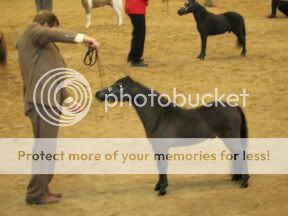These are from the article link I posted the other day. It is from another place with pictures from other breeds and the terms to go with them, but a horse is a horse. Right click and "save picture as" and you can open them in paint and draw in your own lines and comments. Some of them already have comments attached, but it's not in the requested miniature horse world speak. Mistakes do happen, if you see one here or I've gotten pictures flubbed up again please correct it - and thank you for doing so.
Skeletal/Muscle View
From this discussion, page 1
The croup is from the lumbosacral joint to the tail. The "hip" refers to the line running from the ishium of the pelvis (point of the hip) to the point of the buttock.
Picture showing why we look at slope. Here you can see four different "slopes". All other lengths and angles are constant. Can you see how the slope of the hip helps determine leg position? Which horse would you want for a halter horse? For a driving horse? Which horses would assume would be sound, and which would you want to have a soundness check done on? Can you how the position of the hip changes even where the hoof ends up when the horse is standing square? Can you see how some positions allow for heavy or light muscle attachment? Can you see that some angles are going to cause that the legs to do strange things in order to support the horse?
Three examples trying to show the difference between slope and depth:
Athletic "Strong"
Ok length, ok slope, see the point under the arrow where she is peaked and weaker than horse 1?
Weak. Lacking length - someone else mentioned the 30% rule of thumb? Lacking slope, will lack good stride. To use the miniature term, also "butt high"
Usually horses with "strong" hips and have straight legs. If you still don't see it try looking at the muscle on the upper legs of pictures people have posted. Some are nice to look at. Some may strike you as a little different. Compare the hips on those two horses. What in the hip is causing the upper legs to look different? Do you see it now?
Also, there are weak hips, and weak hips! According to the stock horse halter world the hips seen on some of the eventing ponies would be weak just because the halter world tends to looks at bulky muscles as strength, when others would consider a bulky hip a weakness that could hinder a full range of motion - think body builder vs. long distance runner. Two different types of "strength". You are going to like whichever you like best and call the other one "weak". Having a breed type hip (arabian, quarter horse, whatever) isn't a fault. I think if you were to ask the halter/stock folks to pick the best hip on this thread, and then the driving folks to pick the hip they would want to harness - it might be fun to compare the two. I bet they wouldn't be the same.
That's my last post on this topic. Whew! In fact, I think I'm taking a few weeks off after that one!
 what are we actually looking at?
what are we actually looking at?










































































